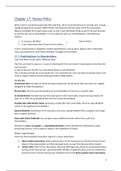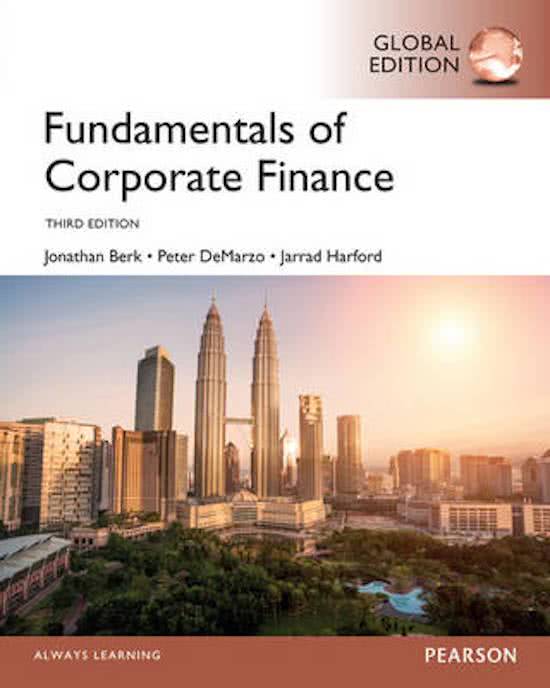Chapter 17: Payout Policy
When a firm’s investments generate free cash flow, the fir must decide how to use that cash. Young,
rapidly growing firms reinvest 100% of their cash flows (so that the value of the firm increases).
Mature, profitable firms have excess cash, so that is can hold those funds as part of its cash reserves
or pay the cash out to shareholders. If a firm pays the cash out to shareholders, they have two
choices:
1. It can pay a dividend Payout Policy
2. It can repurchase shares from current owners.
A firm’s payout policy is shaped by market imperfections, such as taxes, agency costs, transaction
costs, and asymmetric information between managers and investors.
17.1 Distributions to Shareholders
Free cash flows can be used in different ways.
The firm can retain or pay out. In case of retaining the firm can invest in new projects or increase the
cash reserves.
In case of pay out, the firm can repurchase shares or pay dividends.
This is mostly common for an all-equity firm. For a levered firm, free cash flow would also have to be
used to support interest and principal payments to debt holders.
Dividends
Declaration date: the date on which the board authorizes the dividend. After this the firm is legally
obligated to make the payment.
Record date: the firm pays the dividend to all shareholders of record on a specific date.
Ex-dividend date: the date two business days prior to the record date, anyone who purchases the
stock on or after the ex-dividend date will not receive the dividend.
Payable date (distribution date): generally a month after the record date, the firm mails dividend
checks to the registered shareholders.
Special dividend: sometimes a firm may pay a one-time, special dividend that is usually much larger
than a regular dividend.
Stock split (stock dividend): the company issues additional shares rather than cash to its
shareholders.
Dividend as return of capital or a liquidating dividend is when dividend are attributed to other
accounting sources, such as paid-in capital or the liquidation of assets.
Share repurchases
There are three possible transaction types for a share repurchase:
1. Open market repurchase. Most common way. A firm announces its intention to buy its own
shares in the open market, and then proceeds to do so over time like any other investor.
2. Tender offer. Here a firm repurchases shares by offering to buy shares at a prespecified price
during a short time period – generally within 20 days. Usually the price is set at a substantial
premium to the current market price. Related to this is the Dutch auction share repurchase,
1
, in which the firm lists different prices at which it is prepared to buy shares, and shareholders
in turn indicate how many shares they are willing to sell at each price.
3. Targeted Repurchase. A firm may also purchase shares directly form a major shareholder. In
this case the purchase price is negotiated directly with the seller. Greenmail can be done in
this case, if a major shareholder is threatening to take over the firm and remove its
management, then the firm buys out the shareholder.
17.2 Comparison of Dividends and Share Repurchases
Case of Genron. Genron → $20mln in excess cash and no debt. Expects to generate additional free
cash flows of $48mln per year.
r(u)= 12%
Enterprise Value of its ongoing operations?
Enterprise Value= PV (Future FCF) = $48mln / 12% = $400mln
Including the cash, Genron’s total market value is $400mln + $20mln= $420mln
• 10 mln shares outstanding. So they can give out $2 dividend to each shareholder.
• Also, they can reputchase shares instead of paying a dividend.
• Lastly, they can raise the additional cash and pay an even larger dividend today, in
anticipation of the high future FCF it expects to receive.
Alternative policy 1: Dividend with excess cash
Immediately they can pay $2 dividend to the shareholders. Because the firm expects to generate
future FCF of $48mln per year, it anticipates paying adividend of $4,80 per share each year
thereafter. The fair price for the shares is the present value of the expected dividends given Genron’s
equity cost of capital. No debt, so r(u)= 12%. Just before the ex-dividend date, the stock is said to
trade cum-dividend (“with the dividend”). In this case:
P(cum)= Current dividend + PV(Future dividends) = $2 + ($4,,12) = $42
After the stock goes ex-dividend, new buyers will not receive the current dividend.
P(ex)= PV (Future dividends) = ($4,,12) = $40
No arbitrage implies: In a perfect capital market, when a dividend is paid, the share price drops by
the amount of the dividend when the stock begins to trade ex-dividend.
Alternative policy 2: Share repurchase (no dividend)
Initial share price is $420mln / 10mln shares= $42. Use the $20mln to repurchase shares is
$20mln / $42 per share = 0.476 mln shares. Leaving only 10 – 0.476= 9.524 mln shares outstanding.
The price per share is then
$400mln / 9.524 mln shares= $42. This share price is the same, because the market value of the
assets falls when paying out the cash, but the number of shares also falls. This compensates
eachother.
2
,With the future dividends Genron expects to have $48mln in free cash flow. This can be used to pay
dividend of $48mln / 9.524 mln shares= $5.04 per share each year. Thus, with a share repurchase,
Genron’s share price today is
P(rep) = 5..12 = $42
In perfect capital markets, an open market share repurchase has no effect on the stock price, and the
stock price is the same as the cum-dividend price if a dividend were paid instead.
In the case of a share repurchase, by selling shares an investor can create a homemade dividend.
This is when the firm repurchases shares and the investor wants cash, the investor can raise cash by
selling shares.
In perfect capital markets, investors are indifferent between the firm distributing funds via dividends
or share repurchases. By reinvesting dividends or selling shares, they can replicate either payout
method on their own.
Alternative policy 3: High dividend (equity issue)
Because they expect a higher future free cash flow, the firm already wants to pay a higher dividend
immediately. But it has only $20mln cash today, so it needs to raise $28mln to pay the larger
dividend now. An alternative way to raise more cash is to borrow money or sell new shares. Let’s
consider an equity issue. Given a current share price of $42, Genron could raise $28mln by selling
$28mln / $42 per share= 0.67mln shares. The shares outstanding will increase from 10 mln to
10.67mln shares. The amount of the dividend per share each year will be
$48mln / 10.67mln shares= $4.50 per share.
New P(cum)= 4.50 + (4..12)= $42
This means it is the same share price as before, so it has no extra value or benefit to shareholders.
Modigliani-Miller and Dividend Policy Irrelevance
If Genron pays a higher current dividend per share, it will pay lower future dividends per share.
Regardless of the amount of cash he firm has on hand, it can pay a smaller dividend (and use the
remaining cash to repurchase shares) or a larger dividend (by selling equity to raise cash). Such
transactions have no effect on the initial share price.
MM Dividend Irrelevance: In perfect capital markets, holding fixed the investment policy of a firm,
the firm’s choice of dividend policy is irrelevant and does not affect the initial share price.
While dividends do determine share prices, a firm’s choice of dividend policy does not. The value of a
firm ultimately derives from its underlying free cash flow.
17.3 The Tax Disadvantage of Dividends
Shareholders typically must pay taxes on the dividends they receive. When selling their shares, they
must pay capital gain taxes. Shareholders will prefer share repurchases to dividends, since the
dividends are taxed higher than the capital gain rate is. If a firm raises money by issuing shares and
then gives that money back to shareholders as a dividend, shareholders are no better or worse off –
they get the money back they put in.
3
, Example
Firm raises $10mln and uses this to pay shareholders $10mln in dividends. Dividend tax= 40%, capital
gain tax= 15%.
40% van $10mln= $4mln in dividend taxes. Value of firm falls when paying the $10mln cash. Lowering
their capital gains taxes by 15% of $10mln or $1.5mln, because the shareholders’ capital gain on the
stock will be $10mln less when they sell.
Thus, in total shareholders will pay $4mln - $1.5 mln= $2.5mln in taxes, and they will receive back
only $7.5mln of their $10mln investment.
Optimal Dividend Policy with taxes
When the tax rate on dividends exceeds the tax rate on capital gains, shareholders will pay lower
taxes if a firm uses share repurchases for all payouts rather than dividends.
Firms that use dividends will have to pay a higher pre-tax return to offer their investors the same
after-tax returns as firms that use share repurchases. As a result, the optimal dividend policy when
the dividend tax rate exceeds the capital gain tax rate is to pay no dividends at all.
While dividends accounted for more that 80% of corporate payouts until the early 1980s, the
importance of share repurchases grew dramatically in the mid-1980s after the SEC gave guidelines
that provided firms a “safe harbor” from accusations of stock-price manipulation.
The fact that firms continue to issue dividends despite their tax disadvantage is often referred to as
dividend puzzle. Dividends still remain a key form of payouts to shareholders.
17.4 Dividend Capture and Tax Clienteles
Tax rates vary by income, jurisdiction, investment horizon, and whether the stock is held in a
retirement account.
The Effective Dividend Tax Rate
To compare investor preferences, we must quantify the combined effects of dividend and capital
gain taxes to determine an effective dividend tax rate for an investor.
Imagine: John buys a stock today just before it goes ex-dividend, and sells it just after. John qualifies
for, and capture, the dividend. If the stock pays a dividend of amount Div, and John’s dividend tax
rate is 𝝉d then his after-tax cash flow from the dividend is Div(1 - 𝝉d)
If his tax rate on capital gains is 𝝉g, his after-tax loss is (Pcum – Pex)(1 – 𝝉g). Because the price just
before the stock goes ex-dividend, Pcum , exceeds the price just after, Pex, John will expect to incur a
capital loss on his trade.
There is an arbitrage opportunity unless the price drop and dividend are equal after taxes:
(Pcum – Pex)( 1 – 𝝉g) = Div(1 - 𝝉d)
4






